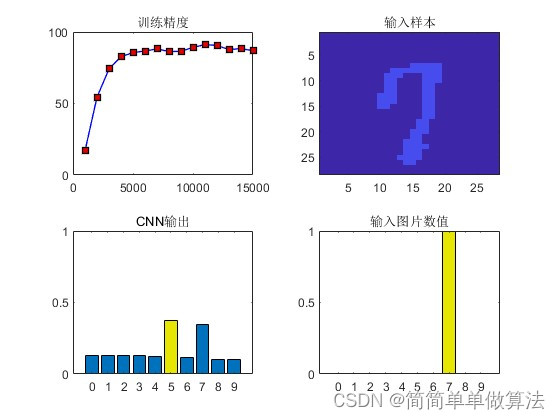本文介绍: 本系列文章记录本人硕士阶段YOLO系列目标检测算法自学及其代码实现的过程。其中算法具体实现借鉴于ultralytics YOLO源码,删减了源码中部分内容,满足个人科研需求。本系列文章在YOLOv5算法实现的基础上,进一步完成YOLOv7算法的实现。
γ(b−mean)+β
BN层->卷积层:构造一个参数为0的卷积层(1×1),实现卷积层+BN层融合
卷积层(3×3)+卷积层(1×1) →卷积层(3×3):将卷积层(1×1)填充为3×3,再将卷积层权重和偏置相加实现融合
2.5.2 模块实现
class RepConv(nn.Module):
def __init__(self, c1, c2, k=3, s=1, p=None, g=1, act=True, deploy=False):
'''
重参数卷积
训练时:
deploy = False
rbr_dense(3x3卷积) + rbr_1x1(1x1卷积) + rbr_identity(c2==c1时)相加
rbr_reparam = None
推理时:
deploy = True
rbr_param = Conv2d
rbr_dense, rbr_1x1, rbr_identity = None, None, None
'''
super().__init__()
self.deploy = deploy
self.groups = g
self.in_channels = c1
self.out_channels = c2
assert k == 3
assert autopad(k, p) == 1
padding_11 = autopad(k, p) - k // 2
self.act = nn.SiLU() if act is True else (act if isinstance(act, nn.Module) else nn.Identity())
# 推理阶段, 仅有一个3x3卷积
if self.deploy:
self.rbr_reparam = nn.Conv2d(c1, c2, k, s, autopad(k, p), groups=g, bias=True)
else:
# 输入输出通道数相同时, identity层(BN层)
self.rbr_identity = (nn.BatchNorm2d(num_features=c1) if c2 == c1 and s == 1 else None)
# 3×3卷积 + BN层
self.rbr_dense = nn.Sequential(
nn.Conv2d(c1, c2, k, s, autopad(k, p), groups=g, bias=False),
nn.BatchNorm2d(num_features=c2),
)
# 1×1卷积 + BN层
self.rbr_1x1 = nn.Sequential(
nn.Conv2d(c1, c2, 1, s, padding_11, groups=g, bias=False),
nn.BatchNorm2d(num_features=c2),
)
def forward(self, x):
# 推理阶段
if hasattr(self, 'rbr_reparam'):
return self.act(self.rbr_reparam(x))
# 训练阶段
if self.rbr_identity is None:
id_out = 0
else:
id_out = self.rbr_identity(x)
return self.act(self.rbr_dense(x) + self.rbr_1x1(x) + id_out)
#融合卷积层和BN层: Conv2D+BN=Conv2D
def fuse_conv_bn(self, conv, bn):
std = (bn.running_var + bn.eps).sqrt()
bias = bn.bias - bn.running_mean * bn.weight / std
t = (bn.weight / std).reshape(-1, 1, 1, 1)
weights = conv.weight * t
bn = nn.Identity()
conv = nn.Conv2d(in_channels=conv.in_channels,
out_channels=conv.out_channels,
kernel_size=conv.kernel_size,
stride=conv.stride,
padding=conv.padding,
dilation=conv.dilation,
groups=conv.groups,
bias=True,
padding_mode=conv.padding_mode)
conv.weight = torch.nn.Parameter(weights)
conv.bias = torch.nn.Parameter(bias)
return conv
# 重参数操作(在推理阶段执行)
def fuse_repvgg_block(self):
if self.deploy:
return
print(f"RepConv.fuse_repvgg_block")
# 融合3x3的卷积层和BN层为一个3x3卷积(有偏置)
self.rbr_dense = self.fuse_conv_bn(self.rbr_dense[0], self.rbr_dense[1])
# 融合1x1的卷积层和BN层为一个1x1卷积(有偏置)
self.rbr_1x1 = self.fuse_conv_bn(self.rbr_1x1[0], self.rbr_1x1[1])
rbr_1x1_bias = self.rbr_1x1.bias
# 填充卷积核大小与3x3卷积大小相同
weight_1x1_expanded = torch.nn.functional.pad(self.rbr_1x1.weight, [1, 1, 1, 1])
# 融合identity的BN层为一个1x1卷积(无偏置)
if isinstance(self.rbr_identity, nn.BatchNorm2d) or isinstance(self.rbr_identity, nn.modules.batchnorm.SyncBatchNorm):
identity_conv_1x1 = nn.Conv2d(
in_channels=self.in_channels,
out_channels=self.out_channels,
kernel_size=1,
stride=1,
padding=0,
groups=self.groups,
bias=False)
identity_conv_1x1.weight.data = identity_conv_1x1.weight.data.to(self.rbr_1x1.weight.data.device)
identity_conv_1x1.weight.data = identity_conv_1x1.weight.data.squeeze().squeeze()
identity_conv_1x1.weight.data.fill_(0.0)
identity_conv_1x1.weight.data.fill_diagonal_(1.0)
identity_conv_1x1.weight.data = identity_conv_1x1.weight.data.unsqueeze(2).unsqueeze(3)
# 融合该1x1卷积和Identity的BN层
identity_conv_1x1 = self.fuse_conv_bn(identity_conv_1x1, self.rbr_identity)
bias_identity_expanded = identity_conv_1x1.bias
weight_identity_expanded = torch.nn.functional.pad(identity_conv_1x1.weight, [1, 1, 1, 1])
else:
bias_identity_expanded = torch.nn.Parameter(torch.zeros_like(rbr_1x1_bias))
weight_identity_expanded = torch.nn.Parameter(torch.zeros_like(weight_1x1_expanded))
# 融合3x3卷积和扩充的1x1卷积的权重和偏置
self.rbr_dense.weight = torch.nn.Parameter(
self.rbr_dense.weight + weight_1x1_expanded + weight_identity_expanded)
self.rbr_dense.bias = torch.nn.Parameter(self.rbr_dense.bias + rbr_1x1_bias + bias_identity_expanded)
self.rbr_reparam = self.rbr_dense
self.deploy = True
if self.rbr_identity is not None:
del self.rbr_identity
self.rbr_identity = None
if self.rbr_1x1 is not None:
del self.rbr_1x1
self.rbr_1x1 = None
if self.rbr_dense is not None:
del self.rbr_dense
self.rbr_dense = None
2.6 Detect模块
Detect模块的具体实现过程可见文章YOLOv5算法实现(二):模型搭建
3 模型配置文件构建(model.yaml)
基于图1所示的模型结构和模型模块所需的参数,构建模型配置文件。其中结构解析包含四个参数[from,number,module,args]:
- from:当前层的输入来自于哪一层
- number:当前层数量
- module:当前层所有模块(在common.py中实现,需与类名对应)
- args:第一个参数为当前层输出通道数,其余参数为模块特有参数;当前层的输入通道数由“from”参数指向的层决定,在结构解析时加入该参数。
# Parameters
nc: 80 # number of classes 类别数
depth_multiple: 1.0 # model depth multiple 模型深度(模块个数系数)
width_multiple: 1.0 # layer channel multiple 模型宽度(模块通道数系数)
anchors:
- [10,13, 16,30, 33,23] # P3/8 (stride=8 feature_map所用Anchor,小目标检测)
- [30,61, 62,45, 59,119] # P4/16 (stride=16 feature_map所用Anchor)
- [116,90, 156,198, 373,326] # P5/32 (stride=32 feature_map所用Anchor,大目标检测)
backbone:
# [from, number, module, args]
[[-1, 1, Conv, [32, 3, 1]], # 0
[-1, 1, Conv, [64, 3, 2]], # 1-P1/2
[-1, 1, Conv, [64, 3, 1]], # 2
[-1, 1, Conv, [128, 3, 2]], # 3-P2/4
[-1, 1, ELAN_B, [256]], # 4
[-1, 1, MP, [256]], # 5-P3/8
[-1, 1, ELAN_B, [512]], # 6
[ -1, 1, MP, [512]], # 7-P4/16
[ -1, 1, ELAN_B, [1024]], # 8
[ -1, 1, MP, [1024]], # 9-P5/32
[ -1, 1, ELAN_B, [1024, 0.25]],# 10
]
head:
[[-1, 1, SPPCSPC, [512]], # 11
[-1, 1, Conv, [256, 1, 1]],
[-1, 1, nn.Upsample, [None, 2, 'nearest']],
[8, 1, Conv, [256, 1, 1]], # route backbone P4
[[-1, -2], 1, Concat, [1]],
[-1, 1, ELAN_H, [256]], # 16
[-1, 1, Conv, [128, 1, 1]],
[-1, 1, nn.Upsample, [None, 2, 'nearest']],
[6, 1, Conv, [128, 1, 1]], # route backbone P3
[[-1, -2], 1, Concat, [1]],
[-1, 1, ELAN_H, [128]], # 21 (P3/8-samll)
[-1, 1, MP, [256]],
[[-1, 16], 1, Concat, [1]],
[-1, 1, ELAN_H, [256]], # 24 (P4/16-medium)
[-1, 1, MP, [512]],
[[-1, 11], 1, Concat, [1]],
[-1, 1, ELAN_H, [512]], # 27 (P5/32-large)
[21, 1, RepConv, [256, 3, 1]], # 28
[24, 1, RepConv, [512, 3, 1]], # 29
[27, 1, RepConv, [1024, 3, 1]], # 30
[[28, 29, 30], 1, Detect, [nc, anchors]], # Detect(P3, P4, P5)
]
4 模型搭建(yolo.py)
模型搭建的具体实现方法可见文章YOLOv5算法实现(二):模型搭建,在
YOLOv7中,在模型类中额外添加一个如下函数实现RepConv模块的融合即可。
def fuse(self):
print('Fusing layers...')
for m in self.model.modules():
if isinstance(m, RepConv):
m.fuse_repvgg_block()
return self
原文地址:https://blog.csdn.net/qq_43676259/article/details/135596294
本文来自互联网用户投稿,该文观点仅代表作者本人,不代表本站立场。本站仅提供信息存储空间服务,不拥有所有权,不承担相关法律责任。
如若转载,请注明出处:http://www.7code.cn/show_56708.html
如若内容造成侵权/违法违规/事实不符,请联系代码007邮箱:suwngjj01@126.com进行投诉反馈,一经查实,立即删除!
主题授权提示:请在后台主题设置-主题授权-激活主题的正版授权,授权购买:RiTheme官网
声明:本站所有文章,如无特殊说明或标注,均为本站原创发布。任何个人或组织,在未征得本站同意时,禁止复制、盗用、采集、发布本站内容到任何网站、书籍等各类媒体平台。如若本站内容侵犯了原著者的合法权益,可联系我们进行处理。






